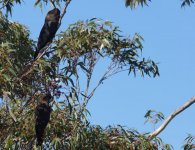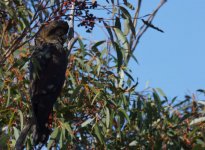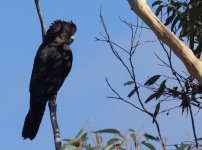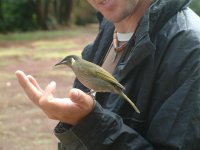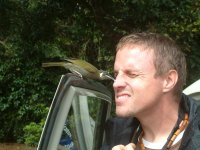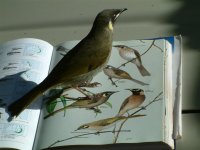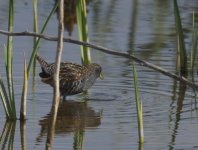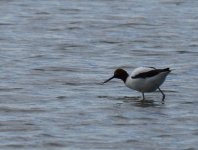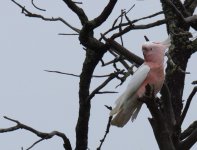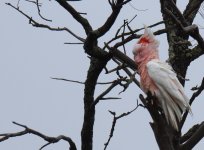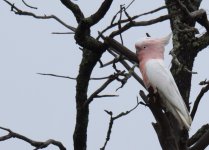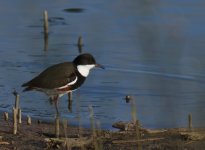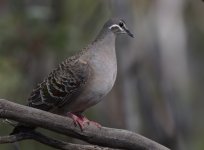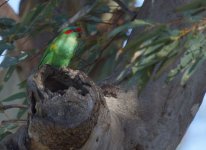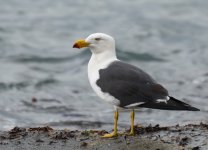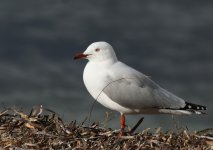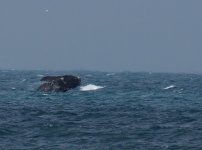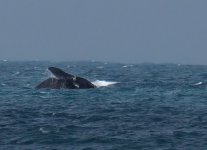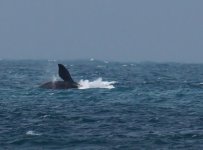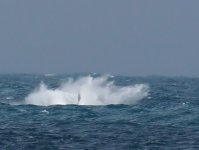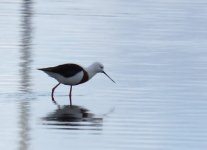-
Welcome to BirdForum, the internet's largest birding community with thousands of members from all over the world. The forums are dedicated to wild birds, birding, binoculars and equipment and all that goes with it.
Please register for an account to take part in the discussions in the forum, post your pictures in the gallery and more.
You are using an out of date browser. It may not display this or other websites correctly.
You should upgrade or use an alternative browser.
You should upgrade or use an alternative browser.
The very wide brown land: Australia - June-August 2013 (1 Viewer)
- Thread starter Andrew Whitehouse
- Start date
More options
Who Replied?Chosun Juan
Given to Fly

.... These are good too: a Superb Lyrebird sequence.
Andy - brilliant Lyrebirds ! Superb !!
In all the years that I've watched them scratch around, fly across the ground, fly way up into trees (maybe now more frequent thanks to marauding Red Foxes - hope someone shot that b*st*rd !), listened to them sing, even sat the other side of a bush while one rattled off 30+ songs up at Kanangra, I've only rarely seen them unfurl the tail feathers - but never "shake a tail feather" Attenborough doco style like you saw ..... Lucky you! |:d| :t:
Have to agree with you about the Yellow-tail Black Cockatoos ..... saw some today in a huge gorge - and their calls are "other worldly" .... carted me straight back to the Jurassic .....
Sounds like you had a great trip! Well done !
Chosun :gh:
Chris D
Well-known member
Great stuff. Lewin's made it's greatest impression on me at O'Reily's. One would fly though the swinging doors into the kitchen (at the restaurant) to eat sugar a cook had out for it. I miss Australia. Great Superb Lyrebirds. I've yet to be where they are. Have seen Albert's though. Awesome.

Day Seventeen: King’s Tableland – Edgell’s Lane, Bathurst – Young
I picked up my campervan in the morning and decided to head west over the Blue Mountains. There was a big difference in the weather in comparison to my previous visit, with blue skies and calm conditions. I turned off the highway to the King’s Tableland, a heathy plateau area. I parked by the sky tower and wandered up the hill – lots of New Holland Honeyeaters in the bushes. A Wedge-tailed Eagle soared past at eye level. Then I heard a few cockatoos calling. First a few Yellow-tailed Black Cockatoos began gliding over the heath but not all of the birds were that species. There were two calls: the high shriek of the Yellow-tailed and another lower rasping sound. Some birds looked a bit smaller and more compact too. And then I noticed the red base to the tail – three of the birds were Glossy Black Cockatoos. This was really good – a bird I’d hoped I might see here but is never very certain anywhere.
They disappeared off eventually and I wandered back down towards the car. As I did so, two cockatoos burst from the scrub just a few feet away – the Glossy Blacks again. They didn’t go too far. When I got back to the car, there they were, just a few metres away and perched up nicely. Both were males with gorgeous brown heads and short, soft crests. They both sat nonchalantly for several minutes – drive away views as it turned out.
Continuing on, I came down from the mountains and into the drier country to the west. An hour or two later I arrived in Bathurst with a vague memory that there were some good wetlands along Edgell’s Lane. And indeed there were – a few small, muddy pools with plenty of birds on them. The only new birds for the trip were rather inauspicious – Goldfinch and Skylark. I got better views of some birds I’d seen earlier in the trip, with several Pink-eared Ducks and Red-kneed Dotterels pottering about at close range, as well as a good selection of other waterfowl.
That was about it for the day, as I continued on through the night to arrive at the town of Young early in the evening.
Here's some Glossy Black goodness.
I picked up my campervan in the morning and decided to head west over the Blue Mountains. There was a big difference in the weather in comparison to my previous visit, with blue skies and calm conditions. I turned off the highway to the King’s Tableland, a heathy plateau area. I parked by the sky tower and wandered up the hill – lots of New Holland Honeyeaters in the bushes. A Wedge-tailed Eagle soared past at eye level. Then I heard a few cockatoos calling. First a few Yellow-tailed Black Cockatoos began gliding over the heath but not all of the birds were that species. There were two calls: the high shriek of the Yellow-tailed and another lower rasping sound. Some birds looked a bit smaller and more compact too. And then I noticed the red base to the tail – three of the birds were Glossy Black Cockatoos. This was really good – a bird I’d hoped I might see here but is never very certain anywhere.
They disappeared off eventually and I wandered back down towards the car. As I did so, two cockatoos burst from the scrub just a few feet away – the Glossy Blacks again. They didn’t go too far. When I got back to the car, there they were, just a few metres away and perched up nicely. Both were males with gorgeous brown heads and short, soft crests. They both sat nonchalantly for several minutes – drive away views as it turned out.
Continuing on, I came down from the mountains and into the drier country to the west. An hour or two later I arrived in Bathurst with a vague memory that there were some good wetlands along Edgell’s Lane. And indeed there were – a few small, muddy pools with plenty of birds on them. The only new birds for the trip were rather inauspicious – Goldfinch and Skylark. I got better views of some birds I’d seen earlier in the trip, with several Pink-eared Ducks and Red-kneed Dotterels pottering about at close range, as well as a good selection of other waterfowl.
That was about it for the day, as I continued on through the night to arrive at the town of Young early in the evening.
Here's some Glossy Black goodness.
Attachments

Thanks for all the comments. I think I got lucky with that Lyrebird - all the others were the devil's own job to see. I actually made a short video of it too, which I'll try and sort out eventually.
birdboybowley
Well-known member.....apparently so ;)

Larry Sweetland
Formerly 'Larry Wheatland'
Enjoying the report, and well done on the Glossy Blacks Andrew, not an easy one for sure :t:
great report
Great Lyrebird shots, and excellent report, makes us really jealous, we only just saw them as they scratched around in the undergrowth.
Great Lyrebird shots, and excellent report, makes us really jealous, we only just saw them as they scratched around in the undergrowth.

Day Eighteen: Young – Fivebough Swamp, Leeton – Deniliquin
This was another day on the road but with some rather good birding along the way. I set off early from Young, whizzing through the rolling countryside, which looked rather greener than I expected. Plenty of birds were along the roadside: Eastern Rosellas, Red-rumped Parrots, a couple of Mallee Ringnecks, White-winged Choughs, Nankeen Kestrels, a Collared Sparrowhawk and Black-shouldered Kites. The best were the little gangs of Apostlebirds that hopped about along the verge. I hoped to get better views when I wasn’t doing a hundred kilometres an hour.
I arrived mid-morning at Fivebough Swamp in Leeton, the day brightening after some early rain. I’d heard a lot of good things about this place, and had high expectations. It took a while to get to any watery areas, but on the way through various weedy patches I had good views of some brilliant male Variegated Fairy-wrens. The scene started to get marshier and soon a few other brown, long-tailed birds were flitting about. These proved to be Little Grassbirds and there were an awful lot of them in the swamp. Often they skulked but sometimes they would trot about over the mud giving good views. Soon after another bird was pecking about at the edge of some rushes – an Australian Crake! Very good – I wondered if these would be about and it didn’t take long to see one. As I wandered around the marshes they were rarely out of sight and eventually I saw at least ten, often at close range and at length. This was clearly all a bit weird – I’ve never been anywhere in the world where crakes are so brazen. I almost had to start ignoring them!
Once I got to the more extensive wetlands, these were absolutely packed with birds. Ducks were numerous, particularly Grey Teal of which there must have been several thousand. Waders were dotted all over the place: dozens of Pied Stilts, Red-necked Avocets, Red-kneed and Black-fronted Dotterel and Red-capped Plovers. Overhead raptors soared: Swamp Harrier, Collared Sparrowhawk, Whistling Kite, Black-shouldered Kite, Nankeen Kestrel and Brown Falcon. In amongst the waterbirds were the occasional Yellow-billed Spoonbill and Glossy Ibis.
After wandering around the marshy pools I got to some slightly deeper lakes overlooked by a hide. Here there were literally hundreds of Purple Swamphens and a good selection of ducks. A little searching soon produced lots of Freckled Ducks – a strange and rather rare species. Eventually I counted 42 but that was probably an underestimate. In the same area a few dark shapes trotted along the banks in between the pools, their tails cocked peculiarly. These three strange birds were Black-tailed Native-hens – real oddities with their chicken-like strut.
Then it was back to the car, stopping to see a few female Red-capped Robins on the way. After picking up some lunch I drove around to the other side of the main pool and viewed the large numbers of ducks there, which included a few hundred Pink-eared Ducks.
Then I was travelling south again to Deniliquin, through miles of grassland and patches of trees. The journey was enlivened by a group of six Emu in a rough field, with another seen further along.
1. Australian Crake
2. Red-necked Avocet
This was another day on the road but with some rather good birding along the way. I set off early from Young, whizzing through the rolling countryside, which looked rather greener than I expected. Plenty of birds were along the roadside: Eastern Rosellas, Red-rumped Parrots, a couple of Mallee Ringnecks, White-winged Choughs, Nankeen Kestrels, a Collared Sparrowhawk and Black-shouldered Kites. The best were the little gangs of Apostlebirds that hopped about along the verge. I hoped to get better views when I wasn’t doing a hundred kilometres an hour.
I arrived mid-morning at Fivebough Swamp in Leeton, the day brightening after some early rain. I’d heard a lot of good things about this place, and had high expectations. It took a while to get to any watery areas, but on the way through various weedy patches I had good views of some brilliant male Variegated Fairy-wrens. The scene started to get marshier and soon a few other brown, long-tailed birds were flitting about. These proved to be Little Grassbirds and there were an awful lot of them in the swamp. Often they skulked but sometimes they would trot about over the mud giving good views. Soon after another bird was pecking about at the edge of some rushes – an Australian Crake! Very good – I wondered if these would be about and it didn’t take long to see one. As I wandered around the marshes they were rarely out of sight and eventually I saw at least ten, often at close range and at length. This was clearly all a bit weird – I’ve never been anywhere in the world where crakes are so brazen. I almost had to start ignoring them!
Once I got to the more extensive wetlands, these were absolutely packed with birds. Ducks were numerous, particularly Grey Teal of which there must have been several thousand. Waders were dotted all over the place: dozens of Pied Stilts, Red-necked Avocets, Red-kneed and Black-fronted Dotterel and Red-capped Plovers. Overhead raptors soared: Swamp Harrier, Collared Sparrowhawk, Whistling Kite, Black-shouldered Kite, Nankeen Kestrel and Brown Falcon. In amongst the waterbirds were the occasional Yellow-billed Spoonbill and Glossy Ibis.
After wandering around the marshy pools I got to some slightly deeper lakes overlooked by a hide. Here there were literally hundreds of Purple Swamphens and a good selection of ducks. A little searching soon produced lots of Freckled Ducks – a strange and rather rare species. Eventually I counted 42 but that was probably an underestimate. In the same area a few dark shapes trotted along the banks in between the pools, their tails cocked peculiarly. These three strange birds were Black-tailed Native-hens – real oddities with their chicken-like strut.
Then it was back to the car, stopping to see a few female Red-capped Robins on the way. After picking up some lunch I drove around to the other side of the main pool and viewed the large numbers of ducks there, which included a few hundred Pink-eared Ducks.
Then I was travelling south again to Deniliquin, through miles of grassland and patches of trees. The journey was enlivened by a group of six Emu in a rough field, with another seen further along.
1. Australian Crake
2. Red-necked Avocet
Attachments

Day Nineteen: Deniliquin – Cobb Highway – Terrick Terrick
I woke up to a chilly, cloudy morning in Deniliquin, but a few birds soon started making themselves present. A couple of Black Kites – the first of the trip – lazily drifted out from their roost. Making a lot of noise as they left their roosts were numerous Long-billed Corellas, bothering the Galahs.
After breakfast I set off for the Island Sanctuary across the river. A cute Black Wallaby greeted me as I crossed the bridge to the island. Western Grey Kangaroos were also very approachable in the park and one had a ‘joey’ poking its head out to investigate. Lots of parrots were about but not the Superb Parrots I was hoping for. It’s not the best time of year for them, but I had hopes that a few might be lingering. I looked around a few other spots in Deniliquin but the only birds of note were a few Plumed Whistling Ducks flying about the sewage works. It’s not possible to see the pools there to any great extent but you can look from nearby and hope a few birds fly about. I’d heard there’d been lots of the whistling ducks lately, and clearly a few lingered.
I continued on southwest and drove down the Cobb Highway. I stopped by the roadside a little to the south of Gulpa Island. A pair of Australian Shelduck flew over the trees. A couple of new passerines for the trip also appeared: a female Rufous Whistler and a couple of Singing Honeyeaters. I crossed into Victoria and continued to Terrick Terrick National Park, where I planned to spend the rest of the day and the night. A small pool by the road at Mitiamo, just south of the park, was absolutely covered with Plumed Whistling Ducks – at least 800. Perhaps these were some of the birds that had been in Deniliquin recently. Curiously when I passed the same pool later in the day there were none.
Terrick Terrick is a beautiful park in the middle of the north Victorian plains. The two small peaks are visible from some distance away. The habitat is a mix of open forest of eucalyptus and pine with a noticeably grassy understory. There are also some areas of native grassland in the farmland to the northeast, which are also in the park and are a noted site for Plains Wanderer. I parked up at the campground next to the ambitiously titled Mount Terrick Terrick, started to make lunch and then it began to rain. It rained for the rest of the day – not really heavily but enough to make birding a bit harder than I’d like. A few birds were about though: Hooded Robins, Jacky Winter and Brown Treecreepers all noticeable. A pair of Diamond Firetails showed well and a small group of Varied Sittellas – one of my favourite Australian birds – investigated a pine tree. Black Wallabies were conspicuous here too.
I headed off to the grasslands mid-afternoon, thinking I’d check them out with a view to looking for Plains Wanderer at night. The rain persisted though, and it was clear that it wasn’t going to disappear any time soon. The prospects weren’t made any more enticing by the almost total lack of any other birds. I’d heard that the wanderers had been scarce the past few years, ever since major flooding in the area, and I hadn’t been too optimistic anyway. I decided that it might be a bit more straightforward to head back to camp and settle in for the evening. The rain lightened slightly but then came back. I hoped it would be gone by the morning.
I woke up to a chilly, cloudy morning in Deniliquin, but a few birds soon started making themselves present. A couple of Black Kites – the first of the trip – lazily drifted out from their roost. Making a lot of noise as they left their roosts were numerous Long-billed Corellas, bothering the Galahs.
After breakfast I set off for the Island Sanctuary across the river. A cute Black Wallaby greeted me as I crossed the bridge to the island. Western Grey Kangaroos were also very approachable in the park and one had a ‘joey’ poking its head out to investigate. Lots of parrots were about but not the Superb Parrots I was hoping for. It’s not the best time of year for them, but I had hopes that a few might be lingering. I looked around a few other spots in Deniliquin but the only birds of note were a few Plumed Whistling Ducks flying about the sewage works. It’s not possible to see the pools there to any great extent but you can look from nearby and hope a few birds fly about. I’d heard there’d been lots of the whistling ducks lately, and clearly a few lingered.
I continued on southwest and drove down the Cobb Highway. I stopped by the roadside a little to the south of Gulpa Island. A pair of Australian Shelduck flew over the trees. A couple of new passerines for the trip also appeared: a female Rufous Whistler and a couple of Singing Honeyeaters. I crossed into Victoria and continued to Terrick Terrick National Park, where I planned to spend the rest of the day and the night. A small pool by the road at Mitiamo, just south of the park, was absolutely covered with Plumed Whistling Ducks – at least 800. Perhaps these were some of the birds that had been in Deniliquin recently. Curiously when I passed the same pool later in the day there were none.
Terrick Terrick is a beautiful park in the middle of the north Victorian plains. The two small peaks are visible from some distance away. The habitat is a mix of open forest of eucalyptus and pine with a noticeably grassy understory. There are also some areas of native grassland in the farmland to the northeast, which are also in the park and are a noted site for Plains Wanderer. I parked up at the campground next to the ambitiously titled Mount Terrick Terrick, started to make lunch and then it began to rain. It rained for the rest of the day – not really heavily but enough to make birding a bit harder than I’d like. A few birds were about though: Hooded Robins, Jacky Winter and Brown Treecreepers all noticeable. A pair of Diamond Firetails showed well and a small group of Varied Sittellas – one of my favourite Australian birds – investigated a pine tree. Black Wallabies were conspicuous here too.
I headed off to the grasslands mid-afternoon, thinking I’d check them out with a view to looking for Plains Wanderer at night. The rain persisted though, and it was clear that it wasn’t going to disappear any time soon. The prospects weren’t made any more enticing by the almost total lack of any other birds. I’d heard that the wanderers had been scarce the past few years, ever since major flooding in the area, and I hadn’t been too optimistic anyway. I decided that it might be a bit more straightforward to head back to camp and settle in for the evening. The rain lightened slightly but then came back. I hoped it would be gone by the morning.

Day Twenty: Terrick Terrick – Lake District – Goschen – Lake Tyrrell – Wyperfeld
It was still raining on and off in the morning and seemed set to continue for the next few hours at least. I decided that my time would be better spent on the road, so I left Terrick Terrick – not really having seen the best of it – and continued on. I did the always entertaining ‘Will I really run out of fuel when the fuel gauge says empty?’ test, which the car just about passed. I filled up in the amusingly named town of Kerang and then continued through the ‘lake district' to the north. I stopped at two lakes called ‘Reedy Lakes’ where there was a bird hide. This was handy because it started to chuck it down once again. A few things were about but nothing too exceptional: Swamp Harrier, Caspian Tern, Australian Shelduck and Royal Spoonbill. Lake Tutchewop is a saline lake a bit further north that can sometimes hold large numbers of birds. Not today though; a few Red-necked Avocets and Red-capped Plovers was about all there was. A pair of Flame Robins was in the fields nearby.
Much better was Round Lake, just a short distance along the Lake Boga – Ultima road. This lake was absolutely packed with ducks – probably at least a thousand Pink-eared Ducks and dozens of equally strange looking Musk Ducks (the only place I saw these on the trip). A lone Freckled Duck floated around but best of all were a tight group of 38 Blue-billed Ducks sat in the middle of the lake. These scarce stifftails weren’t really birds I was expecting in this area, so this was a bonus. The nearby trees held a busy group of Yellow-throated Miners and Singing Honeyeaters.
I continued along the road and stopped for a group of four small parrots. I was glad I did as these were Bluebonnets – a local speciality. Very excellent when you can see the mix of colours in the plumage too. A few more appeared along the roadside through the rest of the day.
I spent the next couple of hours at the reserve at Goschen. Goschen is an abandoned community, which has become a little oasis of flowering trees and shrubs. It’s famed for attracting many enigmatic interior species but sadly those species didn’t seem to be around on my visit. Birds were a bit thin on the ground but I did manage to see my first Spiny-cheeked Honeyeater – quite a strange looking bird – and a busy group of Chestnut-rumped Thornbills.
I carried on along the almost deserted roads until I reached the large Lake Tyrrell, a big salt lake. I didn’t see any birds at all on the water but it was the saltbush around the edge I was interested in. A few melodious twitters and then out popped a Rufous Fieldwren, giving a great show. This is a really neatly streaked bird and I was surprised to see it so easily.
The day was drawing to a close so I found my way to Wyperfeld National Park and the Casuarinas campsite. As night fell, the wind dropped, the skies cleared to reveal the beautiful southern skies and there was almost total silence except for the distant calls of a couple of Southern Boobooks.
It was still raining on and off in the morning and seemed set to continue for the next few hours at least. I decided that my time would be better spent on the road, so I left Terrick Terrick – not really having seen the best of it – and continued on. I did the always entertaining ‘Will I really run out of fuel when the fuel gauge says empty?’ test, which the car just about passed. I filled up in the amusingly named town of Kerang and then continued through the ‘lake district' to the north. I stopped at two lakes called ‘Reedy Lakes’ where there was a bird hide. This was handy because it started to chuck it down once again. A few things were about but nothing too exceptional: Swamp Harrier, Caspian Tern, Australian Shelduck and Royal Spoonbill. Lake Tutchewop is a saline lake a bit further north that can sometimes hold large numbers of birds. Not today though; a few Red-necked Avocets and Red-capped Plovers was about all there was. A pair of Flame Robins was in the fields nearby.
Much better was Round Lake, just a short distance along the Lake Boga – Ultima road. This lake was absolutely packed with ducks – probably at least a thousand Pink-eared Ducks and dozens of equally strange looking Musk Ducks (the only place I saw these on the trip). A lone Freckled Duck floated around but best of all were a tight group of 38 Blue-billed Ducks sat in the middle of the lake. These scarce stifftails weren’t really birds I was expecting in this area, so this was a bonus. The nearby trees held a busy group of Yellow-throated Miners and Singing Honeyeaters.
I continued along the road and stopped for a group of four small parrots. I was glad I did as these were Bluebonnets – a local speciality. Very excellent when you can see the mix of colours in the plumage too. A few more appeared along the roadside through the rest of the day.
I spent the next couple of hours at the reserve at Goschen. Goschen is an abandoned community, which has become a little oasis of flowering trees and shrubs. It’s famed for attracting many enigmatic interior species but sadly those species didn’t seem to be around on my visit. Birds were a bit thin on the ground but I did manage to see my first Spiny-cheeked Honeyeater – quite a strange looking bird – and a busy group of Chestnut-rumped Thornbills.
I carried on along the almost deserted roads until I reached the large Lake Tyrrell, a big salt lake. I didn’t see any birds at all on the water but it was the saltbush around the edge I was interested in. A few melodious twitters and then out popped a Rufous Fieldwren, giving a great show. This is a really neatly streaked bird and I was surprised to see it so easily.
The day was drawing to a close so I found my way to Wyperfeld National Park and the Casuarinas campsite. As night fell, the wind dropped, the skies cleared to reveal the beautiful southern skies and there was almost total silence except for the distant calls of a couple of Southern Boobooks.

Day Twenty-one: Wyperfeld – Hattah-Kulkyne
It was a misty, calm morning at Wyperfeld and once dawn started to break I decided to go for a short drive along the Meridian Track. A few spots were busy with birds, taking in the early morning sun. A couple of active Southern Whitefaces were an excellent start. In amongst the numerous parrots were a small number of brightly coloured Mulga Parrots. Some good arid country birds to get things going.
At the campsite a Peregrine briefly troubled the bountiful Galahs. I then began the loop trail that goes through a range of forest, scrub and grassland habitats. Emus were regularly seen along the walk, usually scampering away at a great lick. A few parties of White-fronted Chats perched up nicely in areas of low herbaceous plants. A good mix of passerines included Singing, Striped and Spiny-cheeked Honeyeaters, Striated Pardalote, Brown Treecreeper, Weebill, Inland, Chestnut-rumped and Yellow-rumped Thornbills, White-browed Babbler, Varied Sittella, Rufous Whistler and Jacky Winter. I was a bit surprised to find some Banded Lapwings in one of the areas of short grass – at least five birds.
Parrots were conspicuous but not initially the ones I was hoping to see. Then, after I’d become a bit exasperated by the constant stream of Galahs, a white shape drifted past, showing nice red colour on the underwing. Great – a Major Mitchell’s Cockatoo. It perched up nicely, still at a bit of a distance, but showing beautiful pastel pink shades. Then another appeared closer by, before joining the other for a bit of tree gnawing and crest fanning. Eventually five appeared, all gathered in one tree. I saw another pair a bit further on and, when I was leaving the park later in the day, a flock of 15 flew up from some roadside scrub.
Wyperfeld was very pleasant but I needed to move. The journey north was sometimes with an eye on the roadside. I travelled along the road from Patchewollock to Ouyen, which earlier in the year had been the scene of a grain spill. The spill had brought out hitherto unheard of numbers of Mallefowl onto the road. I noticed lots of impromptu signs warning travellers to look out for the birds but I guess the grain has all been eaten now.
After collecting supplies in Ouyen – a rather eerie small town that pipes radio broadcasts over loud speakers to a seemingly invisible audience – I continued the short distance to Hattah-Kulkyne National Park.
I had a quick look on Hattah Lake, where the water levels were quite low. Hundreds of Australian Pelicans were loafing about , along with good numbers of Red-necked Avocets and ducks. I decided to drive onwards along the Mournpall Track. A few stops produced my first Splendid Fairy-wrens of the trip, though sadly not a full-on male, as well as other passerines. Rather good were a small group of Regent Parrots – a scarce mallee speciality, which I’d only seen previously in its Western Australian strongholds. Plenty of ducks were on Lake Mournpall, including good numbers of Pink-eared Ducks and Australian Shelducks. I liked it enough to decide to spend the night at the camp ground. A noisy Common Brush-tailed Possum kept me company.
Below, Major Mitchell's Cockatoo in various poses.
It was a misty, calm morning at Wyperfeld and once dawn started to break I decided to go for a short drive along the Meridian Track. A few spots were busy with birds, taking in the early morning sun. A couple of active Southern Whitefaces were an excellent start. In amongst the numerous parrots were a small number of brightly coloured Mulga Parrots. Some good arid country birds to get things going.
At the campsite a Peregrine briefly troubled the bountiful Galahs. I then began the loop trail that goes through a range of forest, scrub and grassland habitats. Emus were regularly seen along the walk, usually scampering away at a great lick. A few parties of White-fronted Chats perched up nicely in areas of low herbaceous plants. A good mix of passerines included Singing, Striped and Spiny-cheeked Honeyeaters, Striated Pardalote, Brown Treecreeper, Weebill, Inland, Chestnut-rumped and Yellow-rumped Thornbills, White-browed Babbler, Varied Sittella, Rufous Whistler and Jacky Winter. I was a bit surprised to find some Banded Lapwings in one of the areas of short grass – at least five birds.
Parrots were conspicuous but not initially the ones I was hoping to see. Then, after I’d become a bit exasperated by the constant stream of Galahs, a white shape drifted past, showing nice red colour on the underwing. Great – a Major Mitchell’s Cockatoo. It perched up nicely, still at a bit of a distance, but showing beautiful pastel pink shades. Then another appeared closer by, before joining the other for a bit of tree gnawing and crest fanning. Eventually five appeared, all gathered in one tree. I saw another pair a bit further on and, when I was leaving the park later in the day, a flock of 15 flew up from some roadside scrub.
Wyperfeld was very pleasant but I needed to move. The journey north was sometimes with an eye on the roadside. I travelled along the road from Patchewollock to Ouyen, which earlier in the year had been the scene of a grain spill. The spill had brought out hitherto unheard of numbers of Mallefowl onto the road. I noticed lots of impromptu signs warning travellers to look out for the birds but I guess the grain has all been eaten now.
After collecting supplies in Ouyen – a rather eerie small town that pipes radio broadcasts over loud speakers to a seemingly invisible audience – I continued the short distance to Hattah-Kulkyne National Park.
I had a quick look on Hattah Lake, where the water levels were quite low. Hundreds of Australian Pelicans were loafing about , along with good numbers of Red-necked Avocets and ducks. I decided to drive onwards along the Mournpall Track. A few stops produced my first Splendid Fairy-wrens of the trip, though sadly not a full-on male, as well as other passerines. Rather good were a small group of Regent Parrots – a scarce mallee speciality, which I’d only seen previously in its Western Australian strongholds. Plenty of ducks were on Lake Mournpall, including good numbers of Pink-eared Ducks and Australian Shelducks. I liked it enough to decide to spend the night at the camp ground. A noisy Common Brush-tailed Possum kept me company.
Below, Major Mitchell's Cockatoo in various poses.
Attachments

Day Twenty-two: Hattah-Kulkyne – Yarrara – Hart Lagoon
It was a fine morning as I set off through the park, driving slowly along the tracks and stopping occasionally, both to allow Emus to cross the road and to look for other birds. A few flocks of honeyeaters included Yellow-plumed, White-eared, Brown-headed and Striped. An unfamiliar and rather penetrating and eerie song put me on to one of the birds I was hoping for: a Crested Bellbird. Other targets were a bit trickier. I stopped at the junction of the Nowingi Track and noticed the extensive spinifex, a tussocky grass, in amongst the mallee scrub. This was definitely the right area. So I spent the next hour-and-a-half tramping through it hoping to hear a squeaking sound. For some time I didn’t even hear anything but eventually there was a squeaking a few metres away. Whatever was making it was moving around but invisibly. I got a brief glimpse of something but still wasn’t really sure what it was. Then everything went quiet again.
I got back to the car, with the day now quite warm. I thought I’d have one last look in the area just next to where I’d parked. Very soon I heard some more squeaking. Then a quick shape moved in the spinifex, just a quick view of a long tail and rufous head and blue throat. Brilliant – a Mallee Emu-wren, the big speciality of Hattah-Kulkyne and a bird that’s hardly found anywhere else. Not great views though. After a bit of a wait there was more squeaking and a better showing, of both the male and a female. Terrific, tiny and colourful birds.
That was enough for Hattah-Kulkyne, though I’d like to have explored it further. I travelled onwards another hour or so to Yarrara, a small bushland reserve in the far northwest of Victoria. It seems like a great place and I’d love to have stayed longer. Sadly I didn’t because I saw all three species I was looking for at my first stop. Driving slowly along the main track I heard what I thought was one target. Getting out of the car, I saw instead another - a White-browed Treecreeper. This is a really smart, contrasting looking bird and much more distinctive than the field guides tend to show. Soon the bird I’d initially heard reappeared, posing for a short time on a dead bush – a Gilbert’s Whistler. These have a really penetrating song that’s very easily identifiable. Then a short wander around the bush turned up a busy party of Chestnut-crowned Babblers, zipping through the scrub. Excellent! Not too many other birds were around, but they included Hooded Robin, Southern Whiteface and Mistletoebird. Crested Bellbird song filled the air.
Then it was across the border into South Australia, through the fruit fly quarantine and on to Waikerie. My final stop of the day wasn’t really planned but I ended up at Hart Lagoon, a sizeable lake on the edge of town. A really excellent place it is too. Freckled Ducks are normally rare and sought after. Not here – I counted over two hundred! Lots of other waterfowl were also about, with Red-necked Avocet, Black-tailed Native-hen and Red-kneed Dotterel all numerous. A few Australian Reed Warblers were seen along the margins. Three Dusky Woodswallows were in amongst the hundreds of hirundines that gathered towards dusk. An Australian Hobby perched in a dead tree, eyeing them up.
Then it was into Waikerie for my first night indoors for five days.
Below, a Red-kneed Dotterel at Hart Lagoon.
It was a fine morning as I set off through the park, driving slowly along the tracks and stopping occasionally, both to allow Emus to cross the road and to look for other birds. A few flocks of honeyeaters included Yellow-plumed, White-eared, Brown-headed and Striped. An unfamiliar and rather penetrating and eerie song put me on to one of the birds I was hoping for: a Crested Bellbird. Other targets were a bit trickier. I stopped at the junction of the Nowingi Track and noticed the extensive spinifex, a tussocky grass, in amongst the mallee scrub. This was definitely the right area. So I spent the next hour-and-a-half tramping through it hoping to hear a squeaking sound. For some time I didn’t even hear anything but eventually there was a squeaking a few metres away. Whatever was making it was moving around but invisibly. I got a brief glimpse of something but still wasn’t really sure what it was. Then everything went quiet again.
I got back to the car, with the day now quite warm. I thought I’d have one last look in the area just next to where I’d parked. Very soon I heard some more squeaking. Then a quick shape moved in the spinifex, just a quick view of a long tail and rufous head and blue throat. Brilliant – a Mallee Emu-wren, the big speciality of Hattah-Kulkyne and a bird that’s hardly found anywhere else. Not great views though. After a bit of a wait there was more squeaking and a better showing, of both the male and a female. Terrific, tiny and colourful birds.
That was enough for Hattah-Kulkyne, though I’d like to have explored it further. I travelled onwards another hour or so to Yarrara, a small bushland reserve in the far northwest of Victoria. It seems like a great place and I’d love to have stayed longer. Sadly I didn’t because I saw all three species I was looking for at my first stop. Driving slowly along the main track I heard what I thought was one target. Getting out of the car, I saw instead another - a White-browed Treecreeper. This is a really smart, contrasting looking bird and much more distinctive than the field guides tend to show. Soon the bird I’d initially heard reappeared, posing for a short time on a dead bush – a Gilbert’s Whistler. These have a really penetrating song that’s very easily identifiable. Then a short wander around the bush turned up a busy party of Chestnut-crowned Babblers, zipping through the scrub. Excellent! Not too many other birds were around, but they included Hooded Robin, Southern Whiteface and Mistletoebird. Crested Bellbird song filled the air.
Then it was across the border into South Australia, through the fruit fly quarantine and on to Waikerie. My final stop of the day wasn’t really planned but I ended up at Hart Lagoon, a sizeable lake on the edge of town. A really excellent place it is too. Freckled Ducks are normally rare and sought after. Not here – I counted over two hundred! Lots of other waterfowl were also about, with Red-necked Avocet, Black-tailed Native-hen and Red-kneed Dotterel all numerous. A few Australian Reed Warblers were seen along the margins. Three Dusky Woodswallows were in amongst the hundreds of hirundines that gathered towards dusk. An Australian Hobby perched in a dead tree, eyeing them up.
Then it was into Waikerie for my first night indoors for five days.
Below, a Red-kneed Dotterel at Hart Lagoon.
Attachments

Day Twenty-three: Gluepot
This was a slightly strange day. I set off in early in the morning for the famous Gluepot reserve, an hour or so to the north. I intended to camp there for the night. I took the ferry across the Murray River and then drove along the gravel track and parked up at the start of Gypsum Lunette walk, which is right at the southern end of the reserve. The walk goes through some fine and varied mallee scrub and spinifex grassland. It’s probably very good for birds on occasions, but despite reasonably fine conditions, almost nothing was happening. I saw barely a handful of birds.
I then continued on until I reached the impressively substantial visitor centre. There I met a couple of volunteers who asked if I was camping for the night. I said I was and they suggested this might not be a good idea, as it was due to rain overnight and it was quite likely the road would be closed and I’d be stranded, possibly for a number of days. The drive in had been fine but there were one or two tricky bits that could become very tricky indeed if there was significant rainfall. The couple also mentioned that there weren’t many birds around at present, something that was also quite believable after the first walk I’d done.
I set off on the Whistler Trail, which again goes through a nice mix of habitats. A spanking male Red-crowned Robin greeted me as I set off but things were again rather quiet. I mournful whistle drifted over from some scrub and I wandered in to see if I could locate its source. It seemed to be coming from the ground but eventually a bird hopped up on a bush to show well – a splendid Southern Scrub Robin. Well, at least that was one of the birds I was hoping to see here. Not too much else was on the walk though: White-browed and Chestnut-crowned Babblers, Hooded Robin, Yellow-plumed Honeyeater. That was about it.
While I was having lunch I was told that the latest forecast was for rain to move in overnight and for it to rain on and off for the next four days. I decided that I should head back to Waikerie for the night, as much convinced by the lack of birds at Gluepot as the weather forecast. I wouldn’t have minded being stuck there for a few days if there was lots about!
I spent the rest of the afternoon around the end of track 8 where again there was almost nothing to be seen. Then, just as I was about to get in the car and leave, I heard a really thin whistle coming from nearby. I had a wander into the scrub. Something moved on the ground behind the bush and then out it popped – a female Chestnut Quail-thrush. This was excellent – not the rarest bird at Gluepot but probably the one I most wanted to see. She showed really well, walking within a few metres. I could hear another bird calling from across the track and then saw it darting across. This was the male and he was absolutely brilliant – a real cacophony of black, chestnut, white and grey. They both continued to give great views for a few minutes before scuttling off.
I was on my way too, and drove back along the track to Waikerie. Gluepot is undoubtedly a great reserve, with many rare species including some that are hardly found anywhere else. It has its bad days and periods though and this seemed to be one of them. I’d seen fewer than thirty species despite looking quite hard. That was it for the mallee too, as I was heading down to the coast for a few days of rather different birding.
Below, a Common Bronzewing - a frequently seen but rather lovely bird.
This was a slightly strange day. I set off in early in the morning for the famous Gluepot reserve, an hour or so to the north. I intended to camp there for the night. I took the ferry across the Murray River and then drove along the gravel track and parked up at the start of Gypsum Lunette walk, which is right at the southern end of the reserve. The walk goes through some fine and varied mallee scrub and spinifex grassland. It’s probably very good for birds on occasions, but despite reasonably fine conditions, almost nothing was happening. I saw barely a handful of birds.
I then continued on until I reached the impressively substantial visitor centre. There I met a couple of volunteers who asked if I was camping for the night. I said I was and they suggested this might not be a good idea, as it was due to rain overnight and it was quite likely the road would be closed and I’d be stranded, possibly for a number of days. The drive in had been fine but there were one or two tricky bits that could become very tricky indeed if there was significant rainfall. The couple also mentioned that there weren’t many birds around at present, something that was also quite believable after the first walk I’d done.
I set off on the Whistler Trail, which again goes through a nice mix of habitats. A spanking male Red-crowned Robin greeted me as I set off but things were again rather quiet. I mournful whistle drifted over from some scrub and I wandered in to see if I could locate its source. It seemed to be coming from the ground but eventually a bird hopped up on a bush to show well – a splendid Southern Scrub Robin. Well, at least that was one of the birds I was hoping to see here. Not too much else was on the walk though: White-browed and Chestnut-crowned Babblers, Hooded Robin, Yellow-plumed Honeyeater. That was about it.
While I was having lunch I was told that the latest forecast was for rain to move in overnight and for it to rain on and off for the next four days. I decided that I should head back to Waikerie for the night, as much convinced by the lack of birds at Gluepot as the weather forecast. I wouldn’t have minded being stuck there for a few days if there was lots about!
I spent the rest of the afternoon around the end of track 8 where again there was almost nothing to be seen. Then, just as I was about to get in the car and leave, I heard a really thin whistle coming from nearby. I had a wander into the scrub. Something moved on the ground behind the bush and then out it popped – a female Chestnut Quail-thrush. This was excellent – not the rarest bird at Gluepot but probably the one I most wanted to see. She showed really well, walking within a few metres. I could hear another bird calling from across the track and then saw it darting across. This was the male and he was absolutely brilliant – a real cacophony of black, chestnut, white and grey. They both continued to give great views for a few minutes before scuttling off.
I was on my way too, and drove back along the track to Waikerie. Gluepot is undoubtedly a great reserve, with many rare species including some that are hardly found anywhere else. It has its bad days and periods though and this seemed to be one of them. I’d seen fewer than thirty species despite looking quite hard. That was it for the mallee too, as I was heading down to the coast for a few days of rather different birding.
Below, a Common Bronzewing - a frequently seen but rather lovely bird.
Attachments

Day Twenty-four: Tanunda Sewage Ponds – Laratinga Wetlands – Victor Harbor
This was a fairly leisurely day in very windy conditions, as I travelled from Waikerie down to the South Australian coast. First stop was Tanunda Sewage Ponds. These are fairly compact and are easily viewable from a public road, which isn’t always true with other sewage works in Australia. Plenty of ducks were about, with Pink-eared Duck especially numerous. The best were five Blue-billed Ducks, which gave closer views than the ones I’d seen a few days earlier.
I drove down through the winding roads of the Adelaide Hills, past numerous vineyards, before arriving at Laratinga Wetlands in Mount Barker. These wetlands were created to treat the town's water and, despite the wind rattling, and sometimes blowing over, the trees, there were plenty of birds about. This is another site where it’s astonishingly easy to see Australian Crake. I had two more-or-less at my feet at one stage. The main bird I was looking for wasn’t a wetland species though, and eventually I managed to find a few. These were Musk Lorikeets, a few of which gave great views as they perched in a wind-battered eucalyptus – really colourful, busy parrots.
Then it was on down to Victor Harbor, dodging numerous fallen branches on the road as I went. I had a look out to sea and was soon watching another new bird: Black-faced Cormorant. These proved to be rather common and surprisingly easy to pick out even at a distance. A few Pacific Gulls sported their massive bills along the beach. I wandered over the causeway to Granite Island, finding a Sooty Oystercatcher in the rocks. Offshore a few Common Dolphins cavorted and on a distant rock there were several loafing New Zealand Fur Seals.
1. Musk Lorikeet
2. Pacific Gull, together with massive bill
3. A more conventionally-billed Silver Gull
This was a fairly leisurely day in very windy conditions, as I travelled from Waikerie down to the South Australian coast. First stop was Tanunda Sewage Ponds. These are fairly compact and are easily viewable from a public road, which isn’t always true with other sewage works in Australia. Plenty of ducks were about, with Pink-eared Duck especially numerous. The best were five Blue-billed Ducks, which gave closer views than the ones I’d seen a few days earlier.
I drove down through the winding roads of the Adelaide Hills, past numerous vineyards, before arriving at Laratinga Wetlands in Mount Barker. These wetlands were created to treat the town's water and, despite the wind rattling, and sometimes blowing over, the trees, there were plenty of birds about. This is another site where it’s astonishingly easy to see Australian Crake. I had two more-or-less at my feet at one stage. The main bird I was looking for wasn’t a wetland species though, and eventually I managed to find a few. These were Musk Lorikeets, a few of which gave great views as they perched in a wind-battered eucalyptus – really colourful, busy parrots.
Then it was on down to Victor Harbor, dodging numerous fallen branches on the road as I went. I had a look out to sea and was soon watching another new bird: Black-faced Cormorant. These proved to be rather common and surprisingly easy to pick out even at a distance. A few Pacific Gulls sported their massive bills along the beach. I wandered over the causeway to Granite Island, finding a Sooty Oystercatcher in the rocks. Offshore a few Common Dolphins cavorted and on a distant rock there were several loafing New Zealand Fur Seals.
1. Musk Lorikeet
2. Pacific Gull, together with massive bill
3. A more conventionally-billed Silver Gull
Attachments

Day Twenty-five: Waitpinga Beach – Goolwa – Hindmarsh Island
This was another breezy and showery day, which eventually proved to be fairly successful despite the conditions. I began at Waitpinga Beach in the Newlands Head Park. I didn’t see an awful lot but got rather wet in a downpour. A Grey Currawong was seen briefly on the way out.
I drove along the coast road towards Goolwa and, as I was doing so, noticed a puff of water coming up from one of the bays near Middleton. I turned right towards the beach and found quite a few other people looking out to sea. In the relatively small bay there were at least five Southern Right Whales. Three were within a few hundred metres and were regularly surfacing. Two more were further out and were breaching regularly – splendid stuff.
I had a brief look around Goolwa Barrage but decided to head across the bridge to Hindmarsh Island. I was mainly hoping to find some Cape Barren Geese in the fields but sadly there weren’t any - it might not be the best time of year. A few other birds were about including both Sooty and Australian Pied Oystercatchers, Swamp Harrier, Red-capped Plover and Royal Spoonbill. Four Black-tailed Native-hens were seen briefly and several New Zealand Fur Seals were bathing at the Murray Mouth. Tantalising views were had of a distant small tern that whizzed through on the breeze.
Next stop was a quick look at Goolwa Sewage Ponds. There were quite a few duck here, at least half of which were Freckled Ducks – over a hundred and fifty. Three Blue-billed Ducks were in amongst them. Then I returned to Goolwa Barrage, continuing a bit further along, past the barrage itself. I walked out to the beach on the other side of the peninsula but didn’t see anything much in another downpour. Things improved as I returned to the car though. First, a Spotted Harrier sailed through the dunes. Then I checked the small group of Crested Terns that were sat at the edge of the car park. At the front of them, barely visible at first, was a tiny Fairy Tern. This was really good – a bird I thought I might struggle to find.
Then with the afternoon drawing to a close I headed back to Waitpinga Beach. There was one bird I was looking for here but there’d been no sign in the morning when the waves were crashing well up the beach. This time I walked down the path to the beach and there in front of me was exactly what I was looking for – a Hooded Plover. Just round the corner were another three. They busily scuttled about along the shoreline like piebald Sanderlings – really smart birds. Out to sea a distant albatross evaded specific identification and a couple of Fluttering Shearwaters were also picked out above the waves – a sign that the wind was pushing a few seabirds inshore.
Below, a breaching Southern Right Whale sequence.
This was another breezy and showery day, which eventually proved to be fairly successful despite the conditions. I began at Waitpinga Beach in the Newlands Head Park. I didn’t see an awful lot but got rather wet in a downpour. A Grey Currawong was seen briefly on the way out.
I drove along the coast road towards Goolwa and, as I was doing so, noticed a puff of water coming up from one of the bays near Middleton. I turned right towards the beach and found quite a few other people looking out to sea. In the relatively small bay there were at least five Southern Right Whales. Three were within a few hundred metres and were regularly surfacing. Two more were further out and were breaching regularly – splendid stuff.
I had a brief look around Goolwa Barrage but decided to head across the bridge to Hindmarsh Island. I was mainly hoping to find some Cape Barren Geese in the fields but sadly there weren’t any - it might not be the best time of year. A few other birds were about including both Sooty and Australian Pied Oystercatchers, Swamp Harrier, Red-capped Plover and Royal Spoonbill. Four Black-tailed Native-hens were seen briefly and several New Zealand Fur Seals were bathing at the Murray Mouth. Tantalising views were had of a distant small tern that whizzed through on the breeze.
Next stop was a quick look at Goolwa Sewage Ponds. There were quite a few duck here, at least half of which were Freckled Ducks – over a hundred and fifty. Three Blue-billed Ducks were in amongst them. Then I returned to Goolwa Barrage, continuing a bit further along, past the barrage itself. I walked out to the beach on the other side of the peninsula but didn’t see anything much in another downpour. Things improved as I returned to the car though. First, a Spotted Harrier sailed through the dunes. Then I checked the small group of Crested Terns that were sat at the edge of the car park. At the front of them, barely visible at first, was a tiny Fairy Tern. This was really good – a bird I thought I might struggle to find.
Then with the afternoon drawing to a close I headed back to Waitpinga Beach. There was one bird I was looking for here but there’d been no sign in the morning when the waves were crashing well up the beach. This time I walked down the path to the beach and there in front of me was exactly what I was looking for – a Hooded Plover. Just round the corner were another three. They busily scuttled about along the shoreline like piebald Sanderlings – really smart birds. Out to sea a distant albatross evaded specific identification and a couple of Fluttering Shearwaters were also picked out above the waves – a sign that the wind was pushing a few seabirds inshore.
Below, a breaching Southern Right Whale sequence.
Attachments

Day Twenty-six: Victor Harbor – St Kilda – Greenfields Wetlands
This was a bit of a duff day, and much the coldest of the trip. I was wandering out to Granite Island in the morning in two shirts, a fleece, an anorak, hat and gloves. The brisk southwesterly was coming straight from the Antarctic, and certainly felt like it. I was hoping it might also have brought in some good seabirds but, aside from a few Australasian Gannets passing by, nothing was happening. I did have one good bird over the sea though, a somewhat unexpected Spotted Harrier. It flew across the bay and then across the slopes of the island, where it attracted the attention of the local Little Ravens. It proved to be the bird of the day.
I headed into Adelaide and tried to find the Greenfield Wetlands, a little to the north of the city centre. They weren’t where I thought they would be and so I decided to go to the mangroves at St Kilda. The boardwalk was partly flooded and there weren’t many birds around with the high water levels. Several Royal Spoonbills flew over. I eventually found the Greenfield Wetlands and spent the rest of the afternoon pottering about there. There were quite a few birds around but nothing new. Little Grassbirds were conspicuous but hard to see well. A Black-tailed Native-hen appeared briefly. A Swamp Harrier drifted about. Then it was up the road to a chilly campsite, where I could at least be warmed by watching the Ashes.
This was a bit of a duff day, and much the coldest of the trip. I was wandering out to Granite Island in the morning in two shirts, a fleece, an anorak, hat and gloves. The brisk southwesterly was coming straight from the Antarctic, and certainly felt like it. I was hoping it might also have brought in some good seabirds but, aside from a few Australasian Gannets passing by, nothing was happening. I did have one good bird over the sea though, a somewhat unexpected Spotted Harrier. It flew across the bay and then across the slopes of the island, where it attracted the attention of the local Little Ravens. It proved to be the bird of the day.
I headed into Adelaide and tried to find the Greenfield Wetlands, a little to the north of the city centre. They weren’t where I thought they would be and so I decided to go to the mangroves at St Kilda. The boardwalk was partly flooded and there weren’t many birds around with the high water levels. Several Royal Spoonbills flew over. I eventually found the Greenfield Wetlands and spent the rest of the afternoon pottering about there. There were quite a few birds around but nothing new. Little Grassbirds were conspicuous but hard to see well. A Black-tailed Native-hen appeared briefly. A Swamp Harrier drifted about. Then it was up the road to a chilly campsite, where I could at least be warmed by watching the Ashes.

Day Twenty-seven: Port Gawler – Thompson’s Beach – Port Augusta
I began the day in the saltmarsh at Port Gawler to the north of Adelaide, the wind still chilly but not as strong as it had been. Yellow-billed Spoonbill and White-fronted Chat soon appeared. A little further along a flock of various small birds were in the bushes along the side of the track. After a bit of searching I had good views of one of the birds I was looking for: Slender-billed Thornbill. A couple of these small, grey-green birds flitted about in the low vegetation, their beady white eyes prominent. The other bird I was looking for didn’t appear until I’d returned to the car. I’d been seeing a few Superb Fairy-wrens in the scrub, giving their typical alternating song. Then I heard a slightly different song coming from fifty yards or so away. On closer approach the culprits could be seen flitting up on to the top of the samphire. These were White-winged Fairy-wrens. There were about five but, as is common with fairy-wrens in the winter, they were all in dull eclipse plumage. White-winged are particularly featureless, slim birds that lack the coloured lores of other fairy-wrens.
After that success I continued up the coast to Thompson’s Beach. Similar species occur there but I was more interested in looking on the mudflats on the beach. Quite a few waders were dotted about here. Most interesting were several Double-banded Plovers – winter visitors from New Zealand. Also around were Sooty and Pied Oystercatchers, Red-capped Plovers, Red-necked Stints and Greenshank. A Fairy Tern drifted along the shoreline before resting up on the sand.
Then it was a long drive northwards and, despite the occasional downpours, the land was getting more arid and the trees started to disappear. Eventually I arrived in Port Augusta and stopped by the lakes on the eastern edge of town. I’d actually seen the bird I was hoping to find before I even stopped the car. Wading around in the shallows was a splendid Banded Stilt. Surprisingly there was just one bird on its own, daintily picking about with its long bill. I soon found a few more – twenty-two in all – on the other side of the road.
In the afternoon I headed to the other side of town and the Arid Lands Botanical Gardens. This is a famous site for a number of desert species. The cool, breezy conditions may not have helped but quite a few of them weren’t visible on this occasion. A few good birds were about though, with a pair of Elegant Parrots giving fine views. A Fairy Martin was in amongst the other hirundines and there were a few other typical interior species such as Spiny-cheeked Honeyeater, Zebra Finch and Mistletoebird. I’d have another crack at the gardens the following morning.
Below, Banded Stilt.
I began the day in the saltmarsh at Port Gawler to the north of Adelaide, the wind still chilly but not as strong as it had been. Yellow-billed Spoonbill and White-fronted Chat soon appeared. A little further along a flock of various small birds were in the bushes along the side of the track. After a bit of searching I had good views of one of the birds I was looking for: Slender-billed Thornbill. A couple of these small, grey-green birds flitted about in the low vegetation, their beady white eyes prominent. The other bird I was looking for didn’t appear until I’d returned to the car. I’d been seeing a few Superb Fairy-wrens in the scrub, giving their typical alternating song. Then I heard a slightly different song coming from fifty yards or so away. On closer approach the culprits could be seen flitting up on to the top of the samphire. These were White-winged Fairy-wrens. There were about five but, as is common with fairy-wrens in the winter, they were all in dull eclipse plumage. White-winged are particularly featureless, slim birds that lack the coloured lores of other fairy-wrens.
After that success I continued up the coast to Thompson’s Beach. Similar species occur there but I was more interested in looking on the mudflats on the beach. Quite a few waders were dotted about here. Most interesting were several Double-banded Plovers – winter visitors from New Zealand. Also around were Sooty and Pied Oystercatchers, Red-capped Plovers, Red-necked Stints and Greenshank. A Fairy Tern drifted along the shoreline before resting up on the sand.
Then it was a long drive northwards and, despite the occasional downpours, the land was getting more arid and the trees started to disappear. Eventually I arrived in Port Augusta and stopped by the lakes on the eastern edge of town. I’d actually seen the bird I was hoping to find before I even stopped the car. Wading around in the shallows was a splendid Banded Stilt. Surprisingly there was just one bird on its own, daintily picking about with its long bill. I soon found a few more – twenty-two in all – on the other side of the road.
In the afternoon I headed to the other side of town and the Arid Lands Botanical Gardens. This is a famous site for a number of desert species. The cool, breezy conditions may not have helped but quite a few of them weren’t visible on this occasion. A few good birds were about though, with a pair of Elegant Parrots giving fine views. A Fairy Martin was in amongst the other hirundines and there were a few other typical interior species such as Spiny-cheeked Honeyeater, Zebra Finch and Mistletoebird. I’d have another crack at the gardens the following morning.
Below, Banded Stilt.
Attachments
Larry Sweetland
Formerly 'Larry Wheatland'
Some great birds there Andrew :t:. shame you couldn't stay at Gluepot, but sounds like you might have otherwise found out the hard way how it got it's name :eek!:
Sad to hear that the plains Wanderers have had a tough time at Terik Terik.
Sad to hear that the plains Wanderers have had a tough time at Terik Terik.
chowchilla
Well-known member
Great stuff Andrew. Lots of interesting experiences there and quite a few lifers for me. All the more reason I need to do more birding down south!:t:
Users who are viewing this thread
Total: 2 (members: 0, guests: 2)





